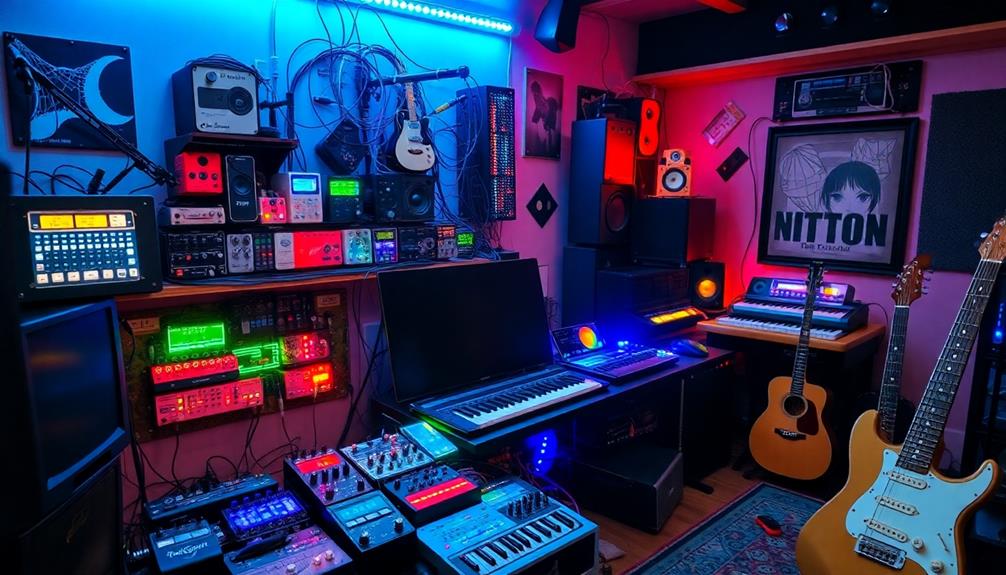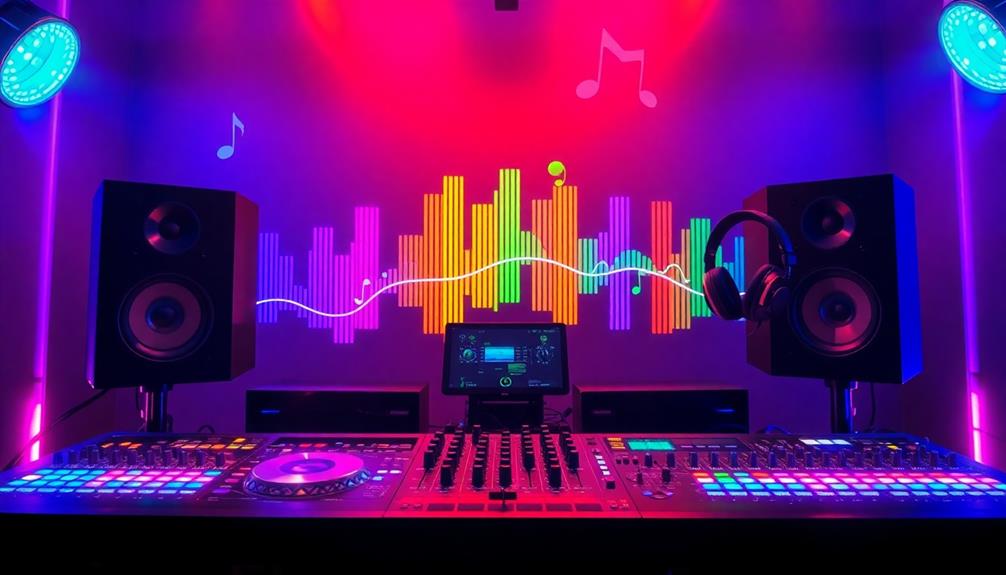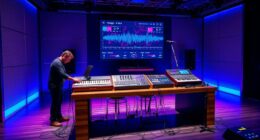To create hyper-realistic Foley for video games, focus on capturing authentic sounds using high-quality microphones, varied surfaces, and vintage equipment for unique textures. Mix layered ambient textures with primary sounds, then process them with EQ, spatial effects, and modulation to add depth and clarity. Accurate placement and seamless integration make certain of immersion. Overcoming environmental noise and embracing innovative techniques are key. Continue exploring to discover how advanced tools and future trends elevate your game’s audio realism.
Key Takeaways
- Use high-quality, vintage, and specialized microphones to capture authentic, detailed Foley sounds in controlled environments.
- Record footsteps and object interactions on varied surfaces, mimicking in-game materials for realism.
- Employ precise layering, equalization, and spatial processing to blend ambient textures with primary sounds seamlessly.
- Incorporate aura dynamics and emotional cues to enhance immersion and evoke specific player responses.
- Utilize innovative techniques like spectral editing and real-time adjustments to refine sound clarity and authenticity.
Understanding the Role of Foley in Video Game Audio

Foley is vital in bringing video game worlds to life by adding realistic sounds that players can feel immersed in. Your role involves creating audio that matches every motion and environment, enhancing believability. Voice modulation is a key tool, allowing you to adjust sounds so they fit different characters, emotions, or situations, making interactions more authentic. Ambient textures also play an important part, filling the space with subtle background sounds that establish mood and setting. These textures help you craft a rich audio landscape, whether it’s the rustling leaves in a forest or distant city noises. By mastering voice modulation and ambient textures, you guarantee every sound contributes to a seamless, immersive game experience that draws players deeper into the virtual world. Regularly assessing and organizing audio assets ensures consistency and quality throughout the project.
Essential Equipment and Techniques for Recording Hyper-Realistic Sounds
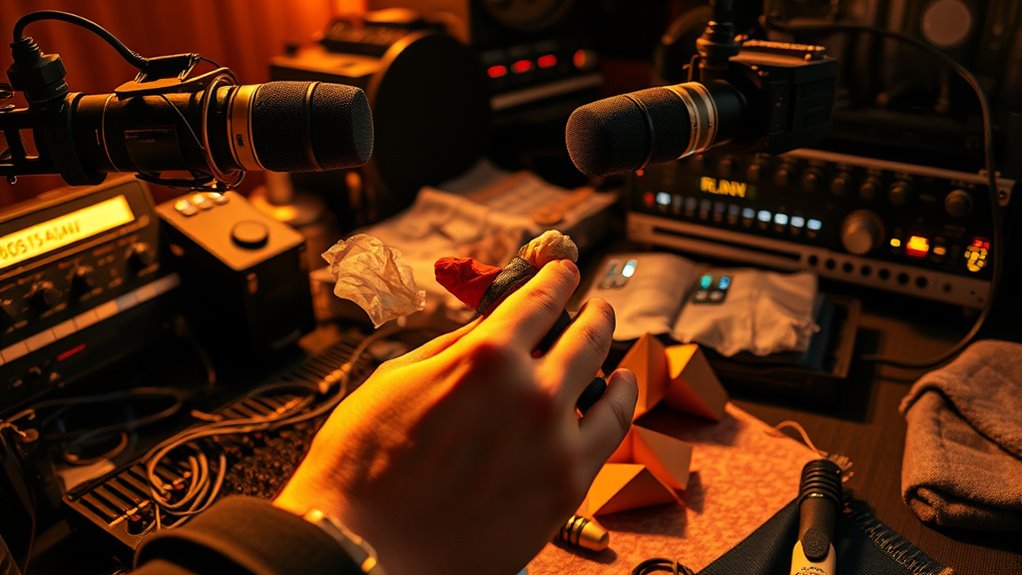
To capture hyper-realistic sounds that truly resonate with players, having the right equipment is fundamental. High-quality microphones are essential for capturing subtle details in ambient textures and Foley assets. Use a pair of matched omnidirectional or cardioid mics for accurate stereo imaging. Proper equipment calibration ensures consistent, clear recordings by adjusting gain levels and input settings. This step minimizes noise and distortion, preserving the integrity of every sound. Invest in portable recorders for on-site captures, and consider acoustic treatment in your recording space to reduce unwanted reflections. Additionally, utilizing windshields and shock mounts helps prevent unwanted noise from handling or environmental factors. With precise calibration and suitable equipment, you’ll be able to capture the nuanced, hyper-realistic sounds that make your game environment immersive and authentic. Understanding headphone jacks can also be beneficial for monitoring recordings and playback to ensure sound quality.
Sourcing and Creating Authentic Foley Assets

Sourcing and creating authentic Foley assets requires a keen ear and creative experimentation to replicate real-world sounds convincingly. Relying on vintage equipment can add unique textures that modern gear can’t match, enriching your Foley artistry. You might record footsteps on varied surfaces or mimic specific interactions with everyday objects, always seeking genuine emotion and realism. Use the following table to inspire your approach:
| Vintage Equipment | Emotional Impact |
|---|---|
| Old reel-to-reel | Nostalgia, authenticity |
| Mechanical devices | Precision, grit |
| Acoustic instruments | Warmth, human touch |
Layering and Processing Sounds for Maximum Realism
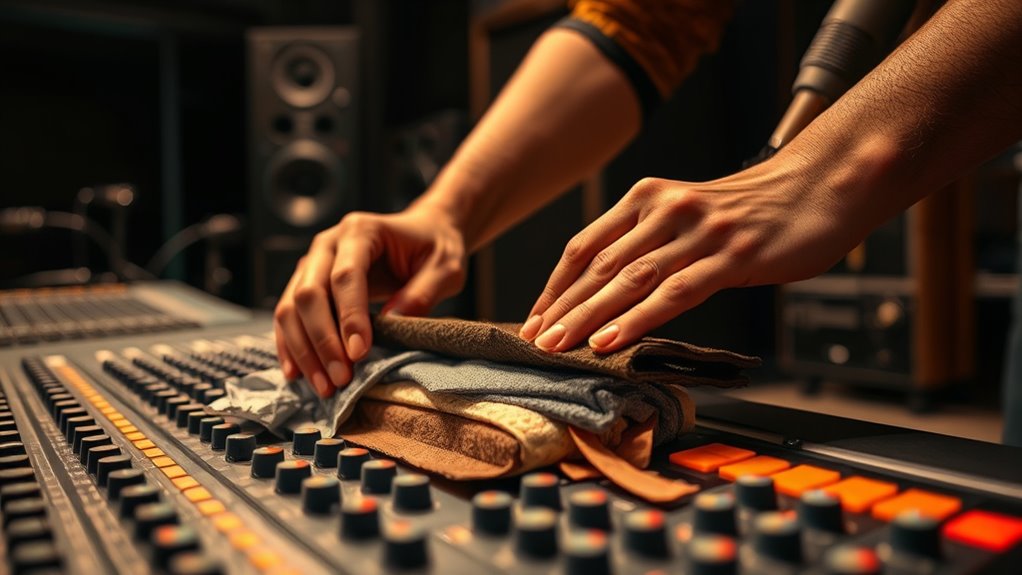
To create truly immersive Foley, you need to carefully layer sounds to add depth and richness. Using equalization and dynamic range adjustments helps each element sit perfectly in the mix. Spatial processing techniques then place sounds accurately within the game’s environment, enhancing realism. Incorporating contrast ratio considerations can also improve the clarity of audio cues in different lighting and visual scenarios, further immersing players.
Layering Techniques for Depth
Layering sounds is essential for creating immersive Foley that feels genuine and three-dimensional. To add depth, combine ambient textures with primary sounds, enriching the environment and making it more believable. Use subtle background layers to evoke emotional cues, guiding players’ feelings and reactions. Proper layering ensures each element complements the others, creating a realistic space that draws players into the game world. Focus on blending different sound sources smoothly for a seamless experience. Pay attention to timing and volume, so no sound overwhelms or gets lost. By thoughtfully layering and processing sounds, you craft a rich auditory landscape that heightens immersion and emotional impact. Incorporating sound design principles can further refine the realism and emotional resonance of your audio environment.
- Evoke feelings of nostalgia, tension, or joy through carefully layered textures
- Create a sense of vastness or intimacy with spatial sound placement
- Enhance realism by mimicking natural sound environments
- Engage players emotionally with subtle ambient cues
- Build a believable, engrossing world that resonates deeply
Equalization and Dynamic Range
Achieving maximum realism in Foley requires precise control over equalization and dynamic range to guarantee sounds blend seamlessly and feel authentic. Equalization helps you shape each sound, emphasizing or reducing specific frequencies to match the environment and context. Dynamic range management, often achieved through audio compression, ensures sounds don’t overpower each other or lose subtle details. Proper compression also helps with sound masking, where certain noises subtly cover unwanted artifacts or background distractions. By balancing these elements, you create a cohesive soundscape that maintains clarity without sounding artificial. Fine-tuning equalization and dynamic range allows you to replicate real-world acoustics, making every footstep, collision, and ambient noise feel naturally integrated into the game environment. Understanding emotional support can also be useful in maintaining focus and patience during the editing process.
Spatial Processing Methods
By carefully layering and processing sounds, you can create a spatially convincing environment that immerses players in the game world. Spatial processing techniques, like binaural rendering, mimic how humans perceive sound direction and distance. You can achieve this by adjusting sound placement, distance cues, and reverberation. Binaural rendering, especially, enhances realism by simulating how ears perceive sound in 3D space. When you layer sounds thoughtfully, you evoke a sense of presence and emotional engagement. Incorporating Vetted – Grobal World concepts such as realistic indoor environments and diverse sound materials can further enhance the authenticity of your audio landscape. – Transport players into a living, breathing environment – Elevate tension with precise spatial cues – Evoke awe through realistic reverberation – Create intimacy with close, detailed sounds – Foster emotional connection via immersive audio layers
Integrating Foley Seamlessly Into the Game Environment

To create truly immersive soundscapes, you need to seamlessly integrate Foley into the game environment so that it feels natural and convincing. Start by blending Foley with ambient textures that match the scene’s setting, ensuring sounds don’t feel out of place. Use spatial processing techniques to position sounds accurately within the 3D space, enhancing realism. Consider how Foley interacts with narrative soundscapes, supporting storytelling without overpowering it. Subtle adjustments, like volume balancing and frequency filtering, help the sounds sit naturally within the mix. Consistently aligning Foley with environmental cues makes the audio feel like an inherent part of the game world. Additionally, understanding aura dynamics can inform how sound elements evoke emotional responses, further immersing players. When done well, this integration draws players deeper into the experience, making every footstep, rustle, or scrape feel authentic and alive.
Challenges and Solutions in Crafting Hyper-Realistic Audio
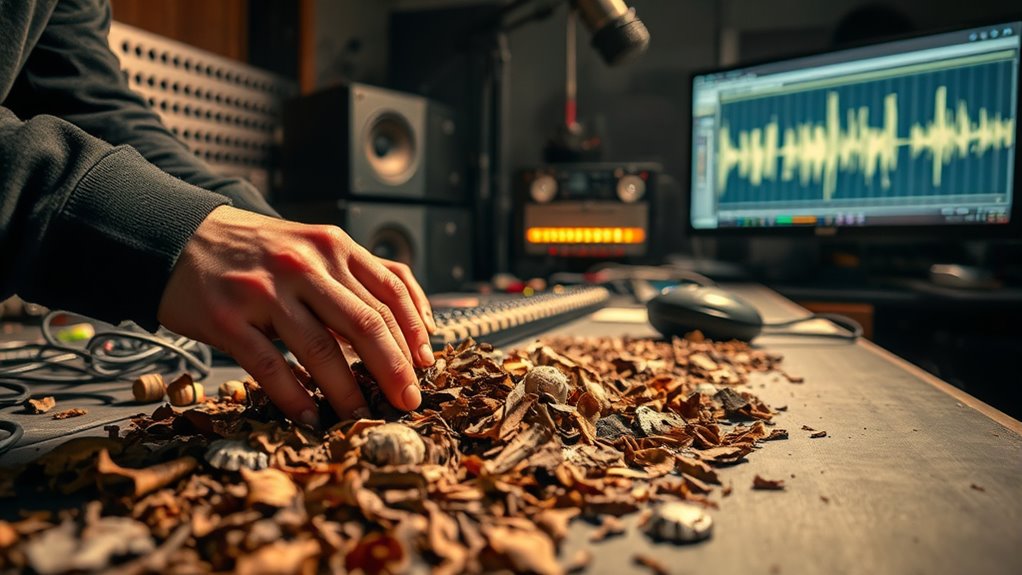
Creating hyper-realistic audio presents unique challenges that demand precise techniques and innovative solutions. You need authentic sound capture methods that preserve natural textures while maintaining clarity. Balancing these aspects often requires advanced post-processing to achieve the perfect mix. Incorporating essential oils as part of your ambient sound design can enhance the perceived realism by adding subtle sensory cues that evoke specific environments or moods.
Authentic Sound Capture Techniques
Capturing authentic sound for hyper-realistic audio involves steering through numerous technical challenges, from environmental noise interference to equipment limitations. To achieve this, you rely on techniques like careful field recording and using vintage microphones that capture warmth and depth. You might brave outdoor conditions, patience, and unpredictable sounds to get the perfect take. The key is precision and adaptability, turning raw recordings into immersive experiences.
- Feel the thrill of discovering the perfect natural sound
- Overcome noisy environments with clever mic placement
- Use vintage microphones to add character and authenticity
- Master the art of subtle adjustments for clarity
- Transform simple recordings into emotional soundscapes through dedicated effort
Balancing Realism and Clarity
Achieving a perfect balance between realism and clarity in hyper-realistic audio can be challenging, as the goal is to preserve the authentic nuances of sounds while ensuring they remain intelligible and immersive. Auditory illusions play a pivotal role here, allowing you to manipulate sound cues so listeners perceive depth and detail without cluttering the mix. Sound symbolism helps you reinforce specific actions or environments through subtle tonal or textural cues, guiding the listener’s perception. To prevent sounds from becoming muddy or overwhelming, you need to carefully shape and layer foley elements. This requires intentional use of spatial placement and dynamic range, ensuring sounds stay true to life yet clear enough to support gameplay. Incorporating spatial audio techniques can further enhance the sense of immersion and realism. Striking this balance enhances immersion without sacrificing clarity.
Innovative Post-Processing Methods
Innovative post-processing techniques are essential for overcoming the challenges of making hyper-realistic audio that maintains both authenticity and clarity. You can enhance ambient textures by carefully layering and fine-tuning soundscapes, immersing players in a believable world. Voice modulation allows you to subtly alter vocal sounds, adding depth and emotional nuance without losing realism. Techniques like spectral editing and dynamic range compression help preserve clarity while retaining naturalness. Using spatial audio tools places sounds precisely, heightening immersion. These methods enable you to craft sounds that evoke powerful emotional responses, making game environments feel alive and convincing.
- Evoke deep emotional connections through ambient textures
- Achieve natural voice modulation that feels authentic
- Balance clarity with immersive depth
- Use spatial audio for precise sound placement
- Push creative boundaries without sacrificing realism
Future Trends and Innovations in Game Sound Design

As technology continues to evolve, game sound design is poised to embrace even more sophisticated tools and techniques that enhance realism and player immersion. Virtual reality will drive innovations, making 3D audio vital for convincing environments. Binaural audio, in particular, will become standard, allowing you to create spatial soundscapes that respond dynamically to player movements. Future trends include real-time adaptive sound that adjusts based on gameplay, and AI-driven sound design, which can generate complex Foley effects on the fly. Haptic feedback integrated with audio will deepen sensory engagement. These advances will blur the line between digital and real-world sound, helping you craft more convincing, immersive experiences that keep players fully engaged within virtual worlds.
Frequently Asked Questions
How Does Player Perspective Influence Foley Design Choices?
Your perspective shapes foley design choices because camera perspective determines how sounds are heard and experienced. If you’re playing from a first-person view, you’ll want sound perspective to match your immediate environment, making footsteps, ambient noises, and interactions feel more immersive. Conversely, a third-person perspective allows for broader sound cues. Adjusting these elements guarantees the audio aligns with what you see, heightening realism and immersion in your gaming experience.
What Are Common Mistakes to Avoid in Hyper-Realistic Foley Creation?
You know that hyper-realistic foley can make or break immersion, so avoid common mistakes. Watch out for audio mismatches that pull players out of the experience and excessive repetition that feels unnatural. Stay attentive to detail, ensuring sounds match actions precisely. Don’t rush the process, and always double-check how sounds blend in context. If you slip up, it’s immediately noticeable—so be meticulous, and your game world will sound convincingly real.
How Can Foley Be Optimized for Different Gaming Platforms?
To optimize Foley for different gaming platforms, you should focus on adaptive mixing to tailor sounds to each system’s capabilities. Consider platform-specific acoustics by adjusting reverb and spatial effects accordingly. You can enhance immersion by fine-tuning audio elements for console, PC, or mobile environments. This approach guarantees your Foley sounds stay realistic and impactful, regardless of the platform, delivering a seamless gaming experience for players everywhere.
What Role Does Player Interaction Play in Foley Immersion?
Did you know that 85% of players say sound enhances their immersion? Player interaction is vital in foley immersion because it directly influences how sound spatialization aligns with your actions. When your movements trigger precise sounds, it boosts your sense of agency and realism. Your active engagement makes the environment feel alive, creating a more authentic experience. So, your interactions shape how immersive and believable the game’s world truly feels.
How Is Environmental Consistency Maintained Across Various Game Levels?
You maintain environmental consistency by focusing on spatial continuity, guaranteeing sounds match the game’s geography and layout. You use sound layering to blend ambient noises seamlessly across levels, creating a cohesive audio experience. By carefully editing and adjusting Foley, you ensure that transitions between levels feel natural, preserving immersion. This approach keeps the game’s soundscape unified, making players feel grounded regardless of where they are within the game’s environment.
Conclusion
Think of creating hyper-realistic Foley as planting a seed in a vast forest. With careful attention, you nurture each sound, allowing it to grow and intertwine seamlessly within the game world. As you refine and layer these sounds, they become the roots and branches that support an immersive experience. When done right, your audio becomes a living part of the environment, inviting players to lose themselves in a truly authentic, vibrant landscape.



